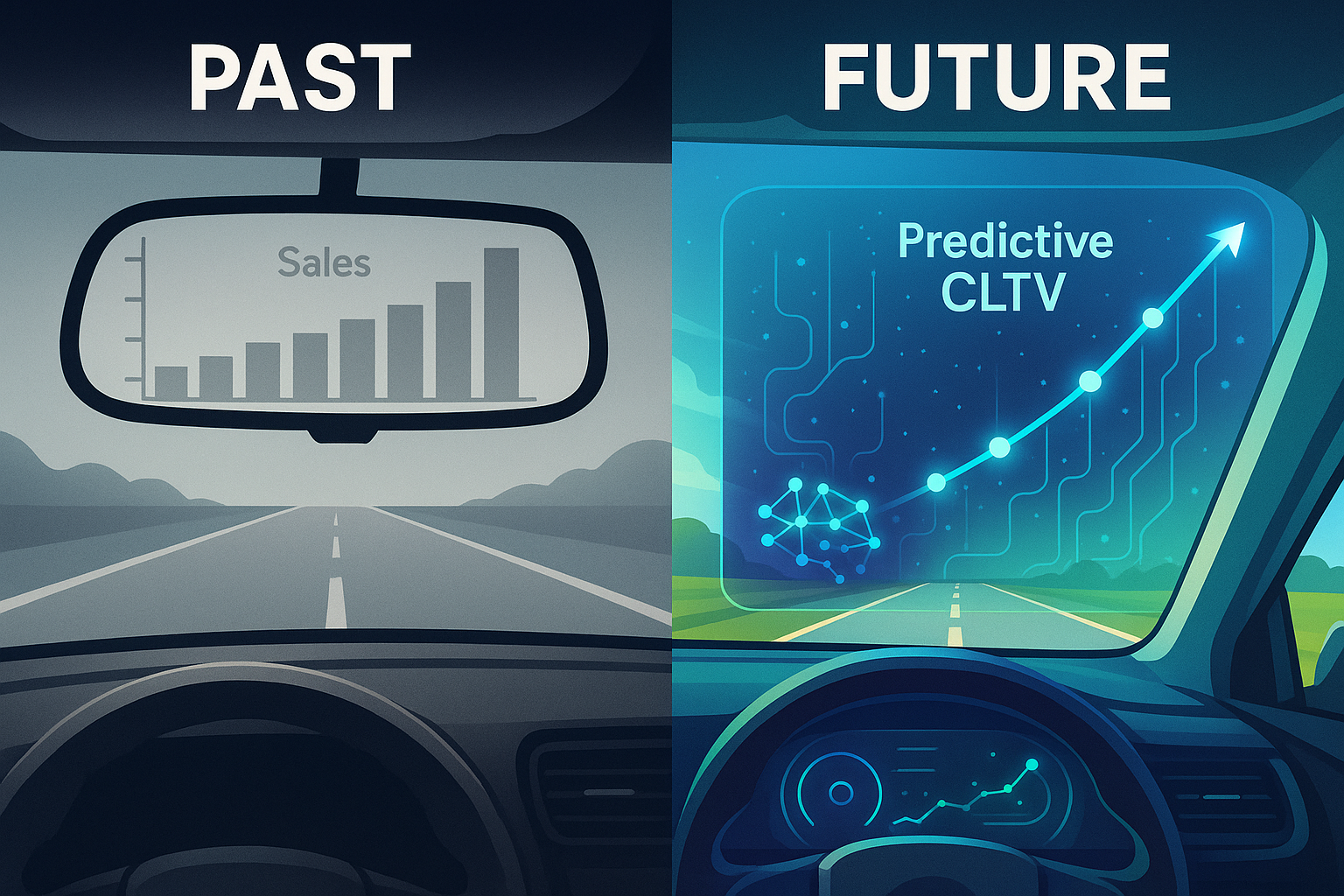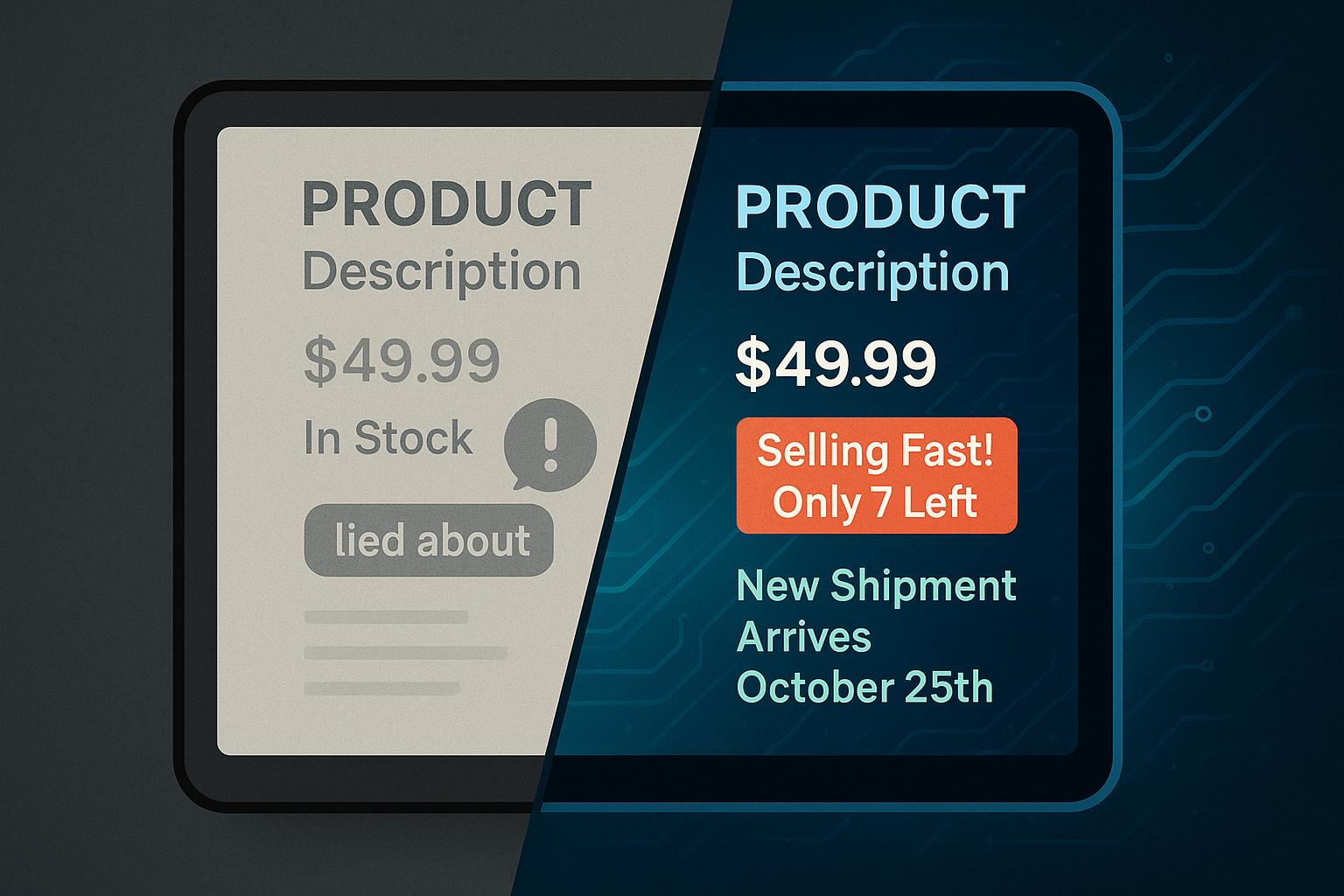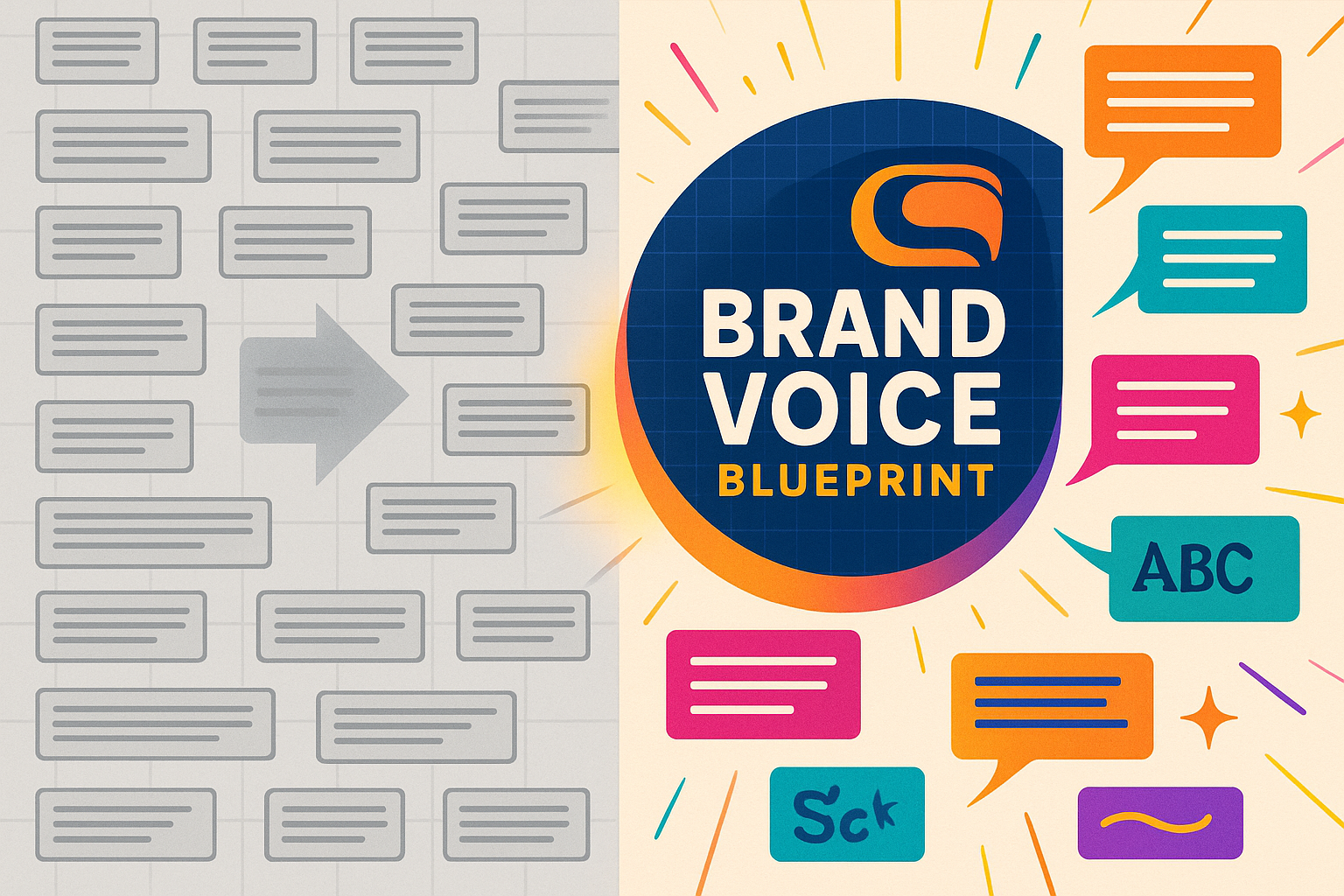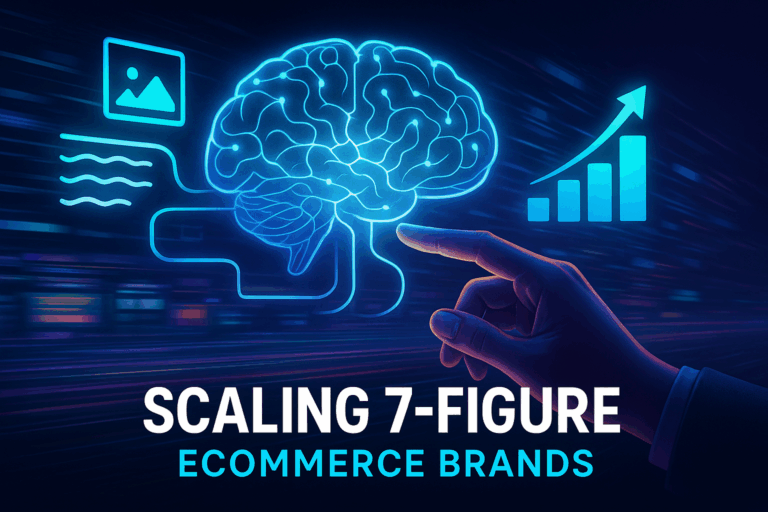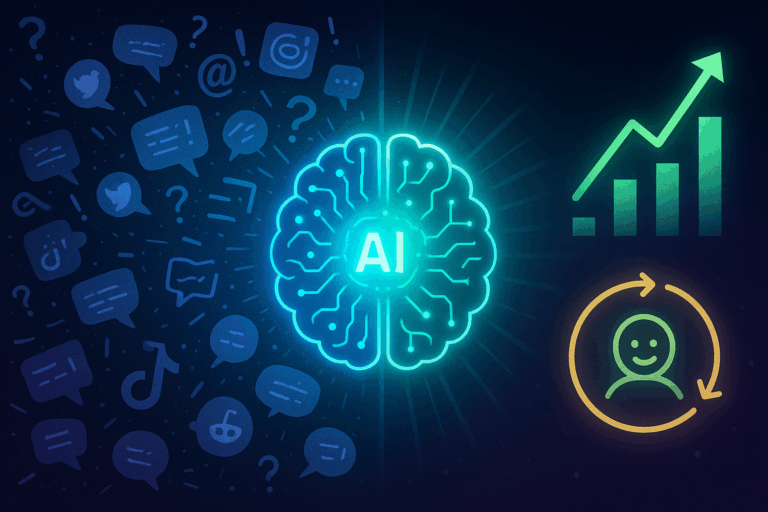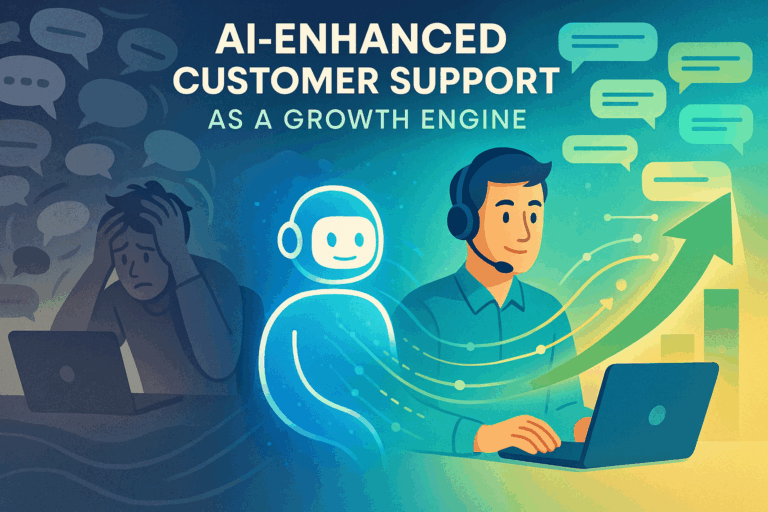Every eCommerce brand wants to find more high-value customers. But most are still looking in the rearview mirror, judging a customer’s worth solely on their past purchases.
It’s like trying to drive forward by only looking at the road you’ve already traveled. You might know where you’ve been, but you have no idea where you’re going.
What if you could predict a customer’s future value the moment they make their first purchase?
Imagine knowing which new buyer is a potential VIP who will spend thousands over the next two years, and which one is a one-time bargain hunter who will never return.
This isn’t a fantasy; it’s the power of predictive analytics for Customer Lifetime Value (CLTV) forecasting. By moving from historical guesswork to AI-powered foresight, you can fundamentally change how you acquire, retain, and invest in your customers.
This guide will demystify the world of predictive CLTV. We’ll break down how it works, why it’s a game-changer for marketing, and how you can start thinking about implementing it—no data science degree required.
The Big Shift: From Historical Guesswork to Predictive Insight
For years, CLTV was a simple, backward-looking formula: (Average Order Value) x (Purchase Frequency) x (Customer Lifespan).
This traditional method is useful, but it has a critical flaw: it treats all customers within a segment as identical averages. It can’t tell you that Customer A, despite a small first purchase, shows behavioral signs of becoming a loyal brand advocate, while Customer B, who made a large initial purchase, was likely a one-off gift buyer.
Predictive CLTV flips the script. It uses machine learning algorithms to analyze vast sets of data—transactions, browsing behavior, demographics—to forecast the future value of each individual customer.
Here’s what this means for your brand: Instead of waiting months or years to identify your best customers, you can spot them early and nurture them proactively.
This shift allows you to move from reactive marketing (like win-back campaigns for customers who have already churned) to proactive strategies (like offering exclusive perks to a customer segment predicted to have high future value).
Core Concepts, Simply Explained
Before we dive deeper, let’s clear up some key terms.
- Customer Lifetime Value (CLTV): The total net profit a company can expect to earn from an individual customer over the entire duration of their relationship. It’s not just about revenue; it’s about long-term profitability.
- Predictive Analytics: A branch of advanced analytics that uses historical data, statistical algorithms, and machine learning techniques to identify the likelihood of future outcomes. In this case, the future outcome is a customer’s total spend.
- Machine Learning (ML): A subset of Artificial Intelligence (AI) where computer systems learn from data to identify patterns and make decisions with minimal human intervention. For CLTV, an ML model might learn that customers who view a specific product category and use a discount code on their first purchase have a 75% higher lifetime value than average.
The synergy is powerful: predictive analytics provides the engine, and CLTV is the destination. It transforms your customer data from a static record of the past into a dynamic roadmap for the future.
The Data-to-Action Pipeline: How Predictive CLTV Actually Works
Predicting the future isn’t magic; it’s a methodical process. Think of it as a pipeline that turns raw customer data into profitable marketing actions. Understanding this flow helps demystify the “black box” of AI.
Step 1: Data – The Fuel for Your Predictive Engine
Your model is only as good as the data it’s fed. Accurate CLTV forecasting relies on a rich, clean dataset. Key data sources include:
- Transactional Data: The bedrock of CLTV. This includes order dates, products purchased, quantities, prices, discounts used, and total spend (RFM – Recency, Frequency, Monetary Value).
- Behavioral Data: How customers interact with your brand. This includes website visits, pages viewed, time spent on site, products added to cart, email opens, and click-through rates.
- Demographic Data: Customer attributes like age, location, and gender, often collected through account sign-ups or surveys.
Practical takeaway: The goal is to collect data that reveals customer intent and engagement, not just their purchase history. A customer who frequently browses your “New Arrivals” page but hasn’t bought in a month is telling you something different than one who hasn’t visited in a year. Getting this data into one place, often with a Customer Data Platform (CDP), is the crucial first step. Your product feeds, managed through [Proprietary Feed Strategies], are a critical source of the product-level data that fuels these insights.
Step 2: Models – The Brains of the Operation
Once you have the data, machine learning models analyze it to find hidden patterns. You don’t need to be a mathematician to understand the different types, but knowing what they do is key.
| Model Type | What It Does Simply | Best For… |
|---|---|---|
| Regression Models | Predicts a continuous value (like future spend). It finds the relationship between variables (e.g., “for every extra site visit, future spend increases by $5”). | Forecasting the exact dollar amount a customer might spend over the next year. |
| Probabilistic Models | Calculates the probability of future events, like “will this customer make another purchase?” and “how much will they spend if they do?” | eCommerce businesses with non-contractual, repeat-purchase models (e.g., fashion, beauty). Models like BG/NBD and Gamma-Gamma are widely used. |
| Classification Models | Puts customers into categories, like “high-value,” “medium-value,” or “likely to churn.” | Segmenting your customer base for targeted campaigns quickly and efficiently. |
The choice of model depends on your specific business goals. Do you need a precise dollar forecast, or do you need to quickly identify customers at risk of leaving? Often, a combination of models provides the most complete picture.
Step 3: Action – Turning Predictions into Profit
This is where the magic happens. The model’s output—a predicted CLTV score for every customer—is integrated into your marketing stack. This allows for hyper-targeted, automated strategies that were impossible with traditional segmentation.
- Smarter Acquisition: Focus your ad spend on acquiring customers who look like your existing high-CLTV segment. You can create lookalike audiences on platforms like Facebook and Google based on your predictive models, drastically improving your Customer Acquisition Cost (CAC) to CLTV ratio.
- Personalized Retention: Instead of sending the same 10% off coupon to everyone, you can create tiered offers. A potential VIP might get early access to a new collection, while a customer flagged as “at-risk” might receive a more aggressive win-back offer.
- Optimized Customer Service: Route customers with the highest predicted CLTV to your top-tier support agents, ensuring they receive a premium experience that reinforces their loyalty.
By operationalizing these insights, often through the use of Custom AI Agents for Ecommerce, you can ensure that these predictive models don’t just sit in a dashboard but actively drive day-to-day marketing decisions.
Beyond Marketing: Advanced Applications and Avoiding Pitfalls
The power of predictive CLTV extends far beyond ad campaigns and email blasts. It can inform core business strategy, but it’s crucial to be aware of the complexities.
Advanced Strategic Uses
- Dynamic Pricing: With an
Ecommerce Competitor Spy Toolmonitoring the market and predictive analytics forecasting demand, you can identify opportunities to adjust prices for specific customer segments without hurting overall sales volume. - Inventory Forecasting: By understanding the future purchasing behavior of your most valuable customer segments, you can more accurately predict demand for certain products, reducing both stockouts and overstock situations.
- Product Development: Analyzing the purchasing patterns of high-CLTV customers can reveal which products or categories are driving the most long-term value, guiding future product development and merchandising decisions.
A Critical Consideration: The Ethics of Predictive Analytics
With great power comes great responsibility. Predictive models learn from historical data, which can contain hidden biases. If a past marketing strategy unintentionally favored one demographic, the model might learn to perpetuate that bias, unfairly labeling certain groups as “low-value.”
Here’s how to be responsible:
- Audit Your Data: Regularly check your data for skews and biases.
- Ensure Model Explainability: Use tools that help you understand why the model is making certain predictions. This prevents “black box” decision-making.
- Human Oversight: Never let the AI run the show completely. Marketing strategists should always review and validate the model’s outputs to ensure they align with brand values and ethical standards.
The future of marketing is defined by smarter data usage and audience relevance. As search and discovery evolve toward AI-driven results, understanding these nuances is essential for effective Generative Engine Optimization (GEO).
Frequently Asked Questions (FAQ)
What is predictive analytics for CLTV forecasting in simple terms?
It’s using AI to look at a customer’s past and current behavior to make a very educated guess about how much profit they will generate for your business in the future.
How does this differ from traditional CLTV?
Traditional CLTV looks backward, calculating value based on past averages. Predictive CLTV looks forward, forecasting the future value of each individual customer based on patterns identified by machine learning.
What data is needed for predictive CLTV?
At a minimum, you need transactional data (what they bought, when, and for how much). To improve accuracy, you should also include behavioral data (website activity, email engagement) and demographic data.
Can small businesses implement predictive analytics for CLTV?
Yes. While it was once the domain of large enterprises, a growing number of platforms and tools are making predictive analytics accessible to smaller eCommerce brands without requiring an in-house data science team.
How are customers segmented using predictive CLTV?
Instead of broad segments like “big spenders,” you can create dynamic, nuanced segments like “Future VIPs,” “High-Potential New Customers,” “Loyal-but-Low-Spenders,” and “At-Risk Churners,” each with a tailored marketing strategy.
Your Next Move: From Learning to Leading
Understanding predictive CLTV is the first step toward building a more resilient, profitable, and customer-centric eCommerce business. You’re no longer just reacting to what customers did yesterday; you’re anticipating their needs for tomorrow.
This isn’t about replacing marketing intuition with algorithms. It’s about amplifying your strategy with data-driven foresight. By identifying your most valuable customers early and investing in them wisely, you can build a powerful engine for sustainable growth that leaves your competitors still staring in the rearview mirror.

